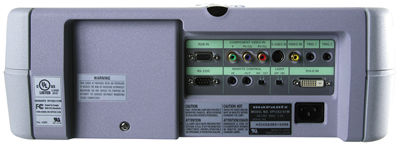Marantz VP-12S2 DLP video front projector

A few projector manufacturers still cater to the eclectic clientele that understands and tolerates the needs of CRTs, but the rest of the industry has switched to plug-and-play display technology, employing transmissive and reflective solid-state light modulators. Liquid-crystal display (LCD), digital light processing (DLP), and liquid crystal on silicon (LCoS) imaging systems are, for now, the future of front-projector technology.
DLP in particular has captured the attention of the home-theater market, thanks to 100% digital signal processing and a small pixel structure that resembles film grain. DLP technology has hit CRT imaging particularly hard—some of the first DLP front projectors to use Texas Instrument's 1280x720 high-definition chips have been so well received that CRT projectors have been eliminated from many manufacturers' product lines.
Still, DLP has its limitations. In the past, the primary complaint about this technology was its inability to reproduce deep black levels and an accurate gray scale. So, earlier this year, TI rolled out the HD2/Mustang digital micromirror device (DMD) to try to improve on these characteristics.
The VP-12S2 is the first Marantz projector to use TI's new HD2 chip. Like the VP-12S1 (see the SGHT review in our July/August 2002 issue, or online at www.guidetohometheater.com), the 12S2 provides both analog and digital video connections, and its single 0.85-inch, 16:9 imaging panel has the same resolution: 1280x720 pixels. Marantz has also included Faroudja's DCDi image processor for improved deinterlacing and motion compensation with 480i input signals.
Out of the Box
The VP-12S2 is no "coffee-table" front projector. You can set it on a table or countertop, but it weighs nearly 30 pounds and is intended for permanent installation. Four adjustable leveling legs provide a good range of height settings in case you do want to put it on a table. Just keep in mind that the heated air from the lamp's cooling fan exhausts out the front, next to the lens.
The supplied projection lens has a limited zoom range and short throw distance, so before purchase and installation you should calculate the available screen-to-projector distance and screen dimensions you anticipate using very carefully—there just isn't much slop room for fine-tuning the image size. For example, with a projection throw of 11' 6", I was able to adjust the image width only between 79 and 91 inches. Marantz offers a long-throw lens option for installations where this may be required.
Marantz has provided a lean but efficient input-connector panel with one input of every flavor: composite (RCA), S-video (DIN), Y-Pb-Pr component (three RCAs), RGB (15-pin HD jack, also known as a VGA jack), and DVI-D input. I would have preferred at least two Y-Pb-Pr inputs, to accommodate a progressive-scan DVD player and a DTV set-top tuner, but the latter connection can be handled by the VP-12S2's RGB or DVI inputs.
This projector is strictly about imaging—as in most consumer-oriented projectors, there's no onboard audio, or even an audio pass-through connection. Marantz does provide a few interface jacks to the outside world, such as the standard RS-232C port for remote control, and two 12V trigger jacks that can be used for operating a motorized screen and controlling the masking on a multiple-aspect-ratio screen.
Remote and Menus
I'm one of those eccentrics who likes my remotes large enough to operate easily; the VP-12S2's remote is a bit small for me. On the plus side, its tiny buttons provide access to most of the functions you'll need to use regularly, such as aspect ratio, gamma correction, and direct access to each of the five video inputs. (Some projectors make you step through all video inputs, whether you've got anything connected to them or not.)
Because the lens has a narrow zoom range and very fine focus, you'll find the VP-12S2's built-in grid test pattern extremely useful for making sure the image is sharp from edge to edge. The lens adjustment itself is not motorized, but it's damped enough to allow for a fine focus adjustment.

It's often necessary to mount a projector in a position that causes the image to be geometrically distorted, particularly in the vertical plane, with the top of the image wider than the bottom, or vice versa. A lens shift feature that moves the lens element up or down in relation to the imaging prism is the proper way to compensate for the "keystone" distortion such (vertical) off-axis projection can cause. This process requires more physical space in the projector housing, but you don't waste any pixels correcting picture geometry.
The Marantz also provides digital keystone correction. In the same menu, you'll also find horizontal and vertical digital image adjustments, which are useful if you watch cable TV or off-air sources with vertical-blanking problems. But I'm no fan of digital keystone correction, because any unlit pixels that do not fall onto light-absorbing surfaces are visible during projection. Use digital keystone correction only as a last resort. It works, but digitally re-mapping the image just wastes pixels [and can also result in jagged line artifacts, particularly at extreme settings—TJN].
As far as input compatibility goes, the VP-12S2 can handle the most common North American and European SDTV standards, including NTSC, PAL, SECAM, 480p/60, and 576p/560. It's also compatible with 720p/60 and 1080i/30 HDTV sources, as well as such oddball progressive rates as the 540p/60 standard used in the popular but now discontinued RCA DTC-100 DTV high-definition broadcast/DirecTV decoder. You can connect your DTV set-top tuner to the VP-12S2 using the component or RGB inputs, and HDTV images always come up in 16:9 mode.




























































